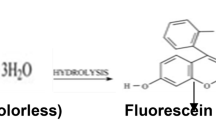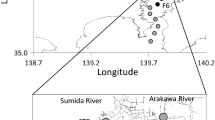Abstract
Purpose
The fluorescein diacetate (FDA) method has been widely used to quantify microbial activity rapidly and sensitively. However, due to high silt–clay ratios and high organic matter contents in urban river sediments, the current FDA methods for soil/coastal sediments may produce errors when applied to urban river sediments. Here, the FDA method was optimized to assess the effects of pollutants on microbial activity.
Materials and methods
Based on their microbial activities, five urban river sediments with different contamination levels were selected for method optimization. The effects of pollutants on microbial activity were assessed using multiple linear regression analysis based on the optimized method.
Results
Reducing the method’s variation coefficient from 1.9% ~ 3.8% to 0.7% ~ 3.3% by increasing the amount of terminator was critical for improving the method’s precision and reproducibility. The fluorescein adsorbed to the sediment was released by ultrasonication in an ice-water bath for 20 min, improving measured microbial activity values. Using the optimized method, we found significant positive correlations between microbial activity and physicochemical indicators. According to multiple linear regression analysis, the influence of different variables on microbial activity diminished in the following order: organic matter > total nitrogen > acidified volatile sulfides > moisture content.
Conclusions
The optimized method reduced the coefficient of variation and improved the measured microbial activity values. Based on the optimized method, multiple linear regression analysis will be helpful for the prediction of pollutant concentrations in urban river sediments.




Similar content being viewed by others
Data availability
The datasets used and/or analyzed during the current study available from the corresponding author on reasonable request.
References
Adam G, Duncan H (2001) Development of a sensitive and rapid method for the measurement of total microbial activity using fluorescein diacetate (FDA) in a range of soils. Soil Biol Biochem 33:943–951. https://doi.org/10.1016/S0038-0717(00)00244-3
Burns RG, DeForest JL, Marxsen J, Sinsabaugh RL, Stromberger ME, Wallenstein MD, Weintraub MN, Zoppini A (2013) Soil enzymes in a changing environment: Current knowledge and future directions. Soil Biol Biochem 58:216–234. https://doi.org/10.1016/j.soilbio.2012.11.009
Cao J, Sun Q, Zhao D, Xu M, Shen Q, Wang D, Wang Y, Ding S (2020) A critical review of the appearance of black-odorous waterbodies in China and treatment methods. J Hazard Mater 385:1–18. https://doi.org/10.1016/j.jhazmat.2019.121511
Chen X, Yang M, Sun J, Yu J, Liu L, Bai S, Bai F, Yang M, Chen Z, He C, Liu X, Liang J, Wang F (2022) The anaerobic oxidation of methane driven by multiple electron acceptors suppresses the release of methane from the sediments of a reservoir. J Soils Sediments 22:682–691. https://doi.org/10.1007/s11368-022-03138-7
DeForest DK, Brix KV, Tear LM, Adams WJ (2017) Multiple linear regression models for predicting chronic aluminum toxicity to freshwater aquatic organisms and developing water quality guidelines. Environ Toxicol Chem 37:80–90. https://doi.org/10.1002/etc.3922
Dzionek A, Dzik J, Wojcieszyńska D, Guzik U (2018) Fluorescein diacetate hydrolysis using the whole biofilm as a sensitive tool to evaluate the physiological state of immobilized bacterial cells. Catalysts 8:1–15. https://doi.org/10.3390/catal8100434
Emmert EAB, Geleta SB, Rose CM, Seho-Ahiable GE, Hawkins AE, Baker KT, Evans AS, Harris ME, Mrozinski AC, Folkoff ME, Anderson PD, Briand CH (2021) Effect of land use changes on soil microbial enzymatic activity and soil microbial community composition on Maryland’s Eastern Shore. Appl Soil Ecol 161:1–7. https://doi.org/10.1016/j.apsoil.2020.103824
Giri S, Mahato MK, Singh AK (2021) Multivariate linear regression models for predicting metal content and sources in leafy vegetables and human health risk assessment in metal mining areas of Southern Jharkhand, India. Environ Sci Pollut R 28:27250–27260. https://doi.org/10.1007/s11356-021-12494-9
Green VS, Stott DE, Diack M (2006) Assay for fluorescein diacetate hydrolytic activity: Optimization for soil samples. Soil Biol Biochem 38:693–701. https://doi.org/10.1016/j.soilbio.2005.06.020
Han X, Schubert CJ, Fiskal A, Dubois N, Lever MA (2020) Eutrophication as a driver of microbial community structure in lake sediments. Environ Microbiol 22:3446–3462. https://doi.org/10.1111/1462-2920.15115
Hsieh YP, Shieh YN (1997) Analysis of reduced inorganic sulfur by diffusion methods: Improved apparatus and evaluation for sulfur isotopic studies. Chem Geol 137:255–261. https://doi.org/10.1016/S0009-2541(96)00159-3
Jiang S, Huang J, Lu H, Liu JC, Yan C (2016) Optimisation for assay of fluorescein diacetate hydrolytic activity as a sensitive tool to evaluate impacts of pollutants and nutrients on microbial activity in coastal sediments. Mar Pollut Bull 110:424–431. https://doi.org/10.1016/j.marpolbul.2016.06.031
Karthikeyan P, Raja P, Kannika MK, Marigoudar SR, Sharma KV (2021) Fluorescein diacetate hydrolysis assay on copepod Tisbe furcata as a new rapid bioassay to assess marine sediment quality. J Earth Syst Sci 130:1–13. https://doi.org/10.1007/s12040-021-01630-1
Li H, Yao J, Gu J, Duran R, Roha B, Jordan G, Liu J, Min N, Lu C (2018) Microcalorimetry and enzyme activity to determine the effect of nickel and sodium butyl xanthate on soil microbial community. Ecotoxicol Environ Saf 163:577–584. https://doi.org/10.1016/j.ecoenv.2018.07.108
Li X, Lu S, Liu S, Zheng Q, Shen P, Wang X (2020) Shifts of bacterial community and molecular ecological network at the presence of fluoroquinolones in a constructed wetland system. Sci Total Environ 708:1–7. https://doi.org/10.1016/j.scitotenv.2019.135156
Lin X, Zheng P, Zou S, Sun F, Zhang X, Gong J (2021) Seagrass (Zostera marina) promotes nitrification potential and selects specific ammonia oxidizers in coastal sediments. J Soils Sediments 21:3259–3273. https://doi.org/10.1007/s11368-021-02951-w
Liu X, Tao Y, Zhou K, Zhang Q, Chen G, Zhang X (2017) Effect of water quality improvement on the remediation of river sediment due to the addition of calcium nitrate. Sci Total Environ 575:887–894. https://doi.org/10.1016/j.scitotenv.2016.09.149
Peng W, Li X, Xiao S, Fan W (2018) Review of remediation technologies for sediments contaminated by heavy metals. J Soils Sediments 18:1701–1719. https://doi.org/10.1007/s11368-018-1921-7
Peng W, Li X, Lin M, Fan W (2020) Microbiological analysis of cadmium-contaminated sediments during biostabilization with indigenous sulfate-reducing bacteria. J Soils Sediments 20:584–593. https://doi.org/10.1007/s11368-019-02415-2
Rozzi A, Remigi E (2004) Methods of assessing microbial activity and inhibition under anaerobic conditions: a literature review. Rev Environ Sci Bio 3:93–115. https://doi.org/10.1007/s11157-004-5762-z
Shah AP, Farooqui S, Maurya DM, Sharma A, Archana G (2022) Linkage of microbial parameters with sediment physicochemical properties in subsurface fluvial sediment deposits of the mahi river basin, western india. Indian J Microbiol 62:257–265. https://doi.org/10.1007/s12088-021-00998-4
Tang Y, Li M, Xu D, Huang J, Sun J (2018) Application potential of aerobic denitrifiers coupled with a biostimulant for nitrogen removal from urban river sediment. Environ Sci Pollut R 25:5980–5993. https://doi.org/10.1007/s11356-017-0903-4
Tao K, Tian H, Fan J, Li D, Liu C, Megharaj M, Li H, Hu M, Jia H, He W (2021) Kinetics and catalytic efficiency of soil fluorescein diacetate hydrolase under the pesticide parathion stress. Sci Total Environ 771:1–10. https://doi.org/10.1016/j.scitotenv.2020.144835
Yin H, Yang P, Kong M (2019) Effects of nitrate dosing on the migration of reduced sulfur in black odorous river sediment and the influencing factors. Chem Eng J 371:516–523. https://doi.org/10.1016/j.cej.2019.04.095
Zhang C, Guo J, Lian J, Song Y, Lu C, Li H (2018) Bio-mixotrophic perchlorate reduction to control sulfate production in a step-feed sulfur-based reactor: A study of kinetics, ORP and bacterial community structure. Bioresour Technol 269:40–49. https://doi.org/10.1016/j.biortech.2018.08.084
Zhao H, Zhao H, Wang S, Zhang L, Qiao Z (2020) Coupling characteristics and environmental significance of nitrogen, phosphorus and organic carbon in the sediments of Erhai Lake. Environ Sci Pollut R 27:19901–19914. https://doi.org/10.1007/s11356-020-08120-9
Acknowledgements
This study was supported by the National Natural Science Foundation of China (Grant No. 51778410 and 51378339). The authors would like to express their gratitude to EditSprings (https://www.editsprings.cn ) for the expert linguistic services provided.
Author information
Authors and Affiliations
Contributions
CZ and JM conceived and designed research; CZ conducted experiments; SZ and JH collected and analyzed the data; CZ wrote the manuscript; SZ and ML provided valuable suggestions on the manuscript; JM and ML revised the manuscript; JM obtained funding and is responsible for this article. All authors read and approved the manuscript.
Corresponding author
Ethics declarations
Conflict of interest
We declare that we have no financial and personal relationships with other people or organizations that can inappropriately influence our work, and there is no professional or other personal interest of any nature or kind in any product, service, and/or company that could be construed as influencing the position presented in, or the review of, the manuscript entitled.
Additional information
Responsible editor: Terrence H. Bell
Publisher's Note
Springer Nature remains neutral with regard to jurisdictional claims in published maps and institutional affiliations.
Highlights
• Variation coefficient values were reduced by increasing the amount of terminator.
• FDA hydrolytic rates were increased by ultrasonication in ice-water.
• OM, TN, and AVS were significantly correlated with FDA hydrolytic rates.
• Regression model could predict pollutant concentrations in the sediment.
Supplementary Information
Below is the link to the electronic supplementary material.
Rights and permissions
Springer Nature or its licensor holds exclusive rights to this article under a publishing agreement with the author(s) or other rightsholder(s); author self-archiving of the accepted manuscript version of this article is solely governed by the terms of such publishing agreement and applicable law.
About this article
Cite this article
Zhang, C., Li, M., Zhang, S. et al. An improved method of fluorescein diacetate determination for assessing the effects of pollutants on microbial activity in urban river sediments. J Soils Sediments 22, 2792–2801 (2022). https://doi.org/10.1007/s11368-022-03319-4
Received:
Accepted:
Published:
Issue Date:
DOI: https://doi.org/10.1007/s11368-022-03319-4




